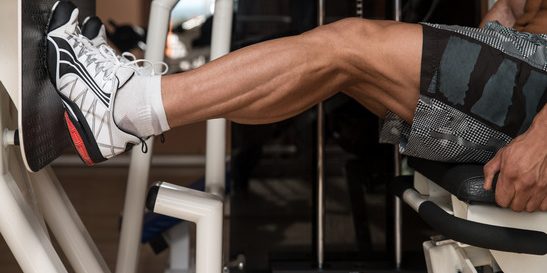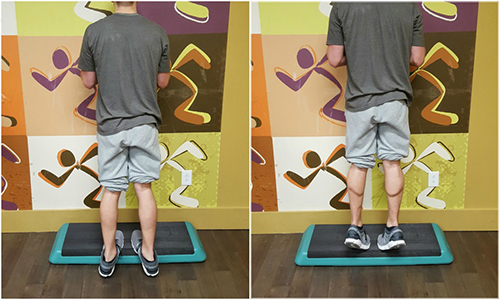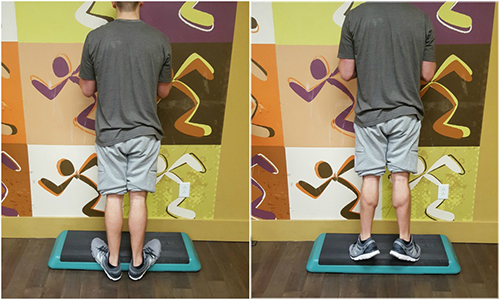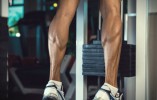How to Make Your Calves Grow. Finally.

This will be the last article that you will ever have to read about the topic of growing your calves. Regardless of what the naysayers claim, the derelict of your current lower half, or even the status quo of your genetics in general for that matter, there is no doubt in my mind that you can in fact grow your calves, probably beyond that to which you envisioned your limitations to be to begin with. Don’t limit yourself!
I know it’s easier said than done, but negative thinking will never lead to positive results.
Now, I’m not going to take it to the philosophical extreme here by stating that “Whatever you can conceive, you can achieve”, because I feel that this famous quote to be somewhat dishonest. I mean, you would never tell a 6’7″ 250 lb high school basketball star that he could become a champion steeplechase jockey one day if he truly in his heart believed it, ignoring his obvious height and weight disadvantages. Would you?
The point I’m trying to make here is not to discourage you, but to simply analyze your current body’s muscular composition and control what you can control. See, in the above example situation, height and weight together can’t really be manipulated much, if any. However, what you can control is the size of muscular tissue, regardless of genetics. We all may not have been born with calves that had the predisposition to bloom into massive, or even fairly muscular calves, but this doesn’t mean that you should just throw in the towel and accept what you don’t desire. Use any negative energy you may have to fuel your efforts instead of thwart them!
So, without further adieu, let me show you how to make your calves grow. Finally.
Stretch! Stretch! Stretch!
If you haven’t heard yet, stretching is one of the best ways to make your calves grow. And no, I’m not talking about dynamic or passive type stretching. I’m talking about stretching withing the individual exercise’s repetition itself.
I feel as though that the calves and the chest muscles both have nothing in common except for this one, unavoidable atrocity that is one half hilarious and another half head-shake worthy. So, what is this repugnant event that I’m speaking of? Well, what other than the world famous 1/8th rep, or if they feel frisky enough, the quarter rep.
This not only looks ridiculous, but more importantly, it’s pointless. You’re basically just bouncing the weight up and down as if it’s a see-saw (e.g. seated calf raise). Of course, one could make the argument that their calves still burn once they finish their reps and they still get a great pump. This is great news to hear. It’s surprising honestly, but still it’s great to hear.
Well, the problem with this is that by not going through the whole range of motion (specifically the bottom), or at least close to it, and by not STRETCHING the calf’s muscle fibers in the eccentric portion of the repetition, you are recruiting significantly less muscle fibers. This, in turn, will result in a lesser muscle pump and decreased lactate build up. Remember, we want quality repetitions here.
*As a side note: It’s ok to do half or quarter reps on your last or second to last set if you are doing so in an attempt to burn your muscles out beyond typical muscular failure. If this is your motive for doing half reps, then I encourage you to do so, otherwise I’d refrain from doing them.
Intensity… Feel the burn!
The calves can withstand an incredible amount of punishment when trained. In fact, they may be the most painful muscle to train. If you aren’t feeling this intensive lactic acid burning sensation when you exercise them, then you just plain aren’t training them hard enough. This most likely goes for every muscle group, but being that the calves tend to burn very badly once you get close to failure, most people call it quits right there. Don’t do this.
You should be going to failure on at least one of your sets (being your last set of course). However, when I train calves, I usually go to failure on my second set, go past failure on my third set with a handful of half reps, and then go even further by squeezing out as many partial (quarter reps) as I can on my fourth and final set. Yes, it burns like hell. Nevertheless, if you want your calves to grow, you’re going to have to be able to tolerate a lot of pain.
When should you train calves?
Well, depending on your purpose, this answer will vary. However, this article is about growing your calves, right? So, I would recommend training them no more than twice a week. I actually like the idea of training them first, this way I won’t give a halfhearted effort after an hour long bout with the weights.
I like the idea of training calves on an upper body day. This way, when you do train your thighs, you will be able to give it the attention, effort, and stamina it requires (e.g. squats, lunges, leg presses). Training calves with thighs just seems like an over kill to me. But to each is own. Regardless of when you train them, just make sure that you keep your intensity up.
As you begin to start training your calves with more vigor and fierceness, you may get to a point to where your calves are no longer getting sore anymore, and even worse, not growing. This stagnating plateau is bound to happen when training any muscle group. With this being said, you must incorporate some type of change in your routine to spark growth by stimulating and honing in on new muscle fibers. A great way to do this is to manipulate your foot positions to emphasize specific areas of your calves.
Experimenting with different foot positions
This is an incredible way for you to blast past plateaus and promote growth in new areas in the calves. Using different foot positions for the calves allows you to emphasize either the inner most fibers or the outer most fibers.
If you perform a standing calf raise with your toes pointed inward (virtually touching), then you are emphasizing the outer calves.

Inversely, if you do calf raises with your toes pointed outward (with your heels virtually touching), then you’ll be emphasizing the inner calf muscles. This type of technique is very similar to bicep training.

The icing on the cake is when you either finish or begin (either is fine) your calf workout with seated calf raises. Only in this position can you truly target the soleus muscle of the calves, which is the lower most portion of the calf muscle. As the knee’s bend closer to a 90 degree angle (like with seated calf raises), the gastrocnemius muscle takes a backseat and the soleus muscle takes over.
Now, even though it can be somewhat difficult to truly get a full range of motion in this seated position, like with the standing calf raise version, you should still try your best to do so. So, you now have the knowledge to allow you to attain the calves you desire. Don’t let doubt and negative thinking diminish your goals! Also, let the naysayers motivate you. Use that negative energy to prove them wrong. On a final note, just remember that YOU CAN in fact grow your calves if you diligently work hard at it and believe in your ability to do so.



